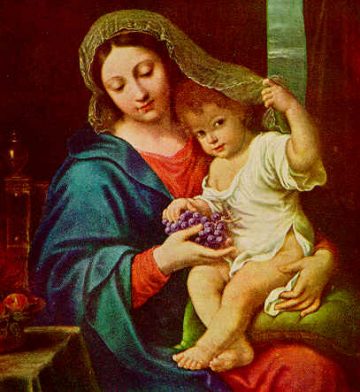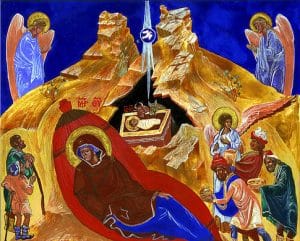Click for French Translation/Traduction en français
Each one of these visiting teaching messages, including this month’s, comes with a question or questions at the end of the message, probably meant to encourage discussion. I often disregard them as too “preachy” for a Visiting Teaching conversation, however, the single query at the end of this month’s message made me think. And wonder, and….as always, consider how and why this is important to women.
So I start this post in asking that question:
“Why is it important to understand the Savior’s role as the Messiah?”
First, I think it is important to differentiate between the terms: Savior/ Saviour and Messiah. The term savior is defined as someone who saves, rescues, or delivers. The term Messiah is more antiquated as per its Hebrew origin (māshīach), and means “anointed one.” In combination, the Savior who is also Messiah is one who is anointed to save.
From the message:
“[Jesus Christ] is the Savior and Redeemer of the world,” said President Dieter F. Uchtdorf, Second Counselor in the First Presidency. “He is the promised Messiah. He lived a perfect life and atoned for our sins. He will ever be at our side. He will fight our battles. He is our hope; He is our salvation; He is the way.”
Jesus is the only individual who was anointed to serve in the great capacity of the Atonement. Consider the concept of being anointed: one who is anointed is consecrated, usually by means of a ritual that involves prayer, oils and even perfumes. (The term “consecrate” means to declare sacredness). According to 2 Corinthians 1:21:
Now he which stablisheth us with you in Christ, and hath anointed us, is God;”–
This can be understood to mean that God anointed us, i.e. we are consecrated (sacredly connected) to Christ, even before we are baptised– even if we don’t know if He exists, even when we make choices that are contrary to what we are taught at church. We are consecrated daughters of God, and through the Savior (Christ), all can return to God as a result of this anointing.
From the message:
Elder Jeffrey R. Holland of the Quorum of the Twelve Apostles testified: “I know [Jesus Christ] is the Holy One of Israel, the Messiah who will one day come again in final glory, to reign on earth as Lord of lords and King of kings. I know that there is no other name given under heaven whereby a man [or woman] can be saved.”
As usual, I was trying to think of ways in which this idea can be practically applied to women. I thought of the anointing of Elizabeth II prior to her coronation as Queen and I noticed the veil used in the anointing part of her coronation. In this, I thought of the use of the veil in mourning practices during the Victorian era, and of the veiling of women in cultural and religious contexts, most often as means of declaring the space sacred (not to be confused with “modest”).
The symbol of the veil is often used to depict spaces that are anointed by Christ’s presence in art, including the image used in this post. The veil is used in scripture as a symbol of the divide between God and imperfect mortals. However, as we are anointed unto Christ (2 Corinthians 1:21) , the death and resurrection of Christ destroys the veil. Therefore, we become eligible though Christ to share in the presence of God without reserve. (Matthew 27:51 And, behold, the veil of the temple* was rent in twain from the top to the bottom; and the earth did quake , and the rocks rent).
This means that ALL become eligible to receive revelation and direction from God. It does not matter who we are. Our economic or religious affiliation do not matter: Through Christ, as savior—we are saved from our sins, He becomes our Mediator, and through this, the veil is burst- thereby allowing us direct communication with God. This is especially important to me as I sit in a church that seems to have a long line of male church officers who are layered in ranks of a bureaucracy that sometimes seems to make General Authorities into untouchable, disassociated celebrities. But the truth is, communion with Christ and my Heavenly Parents can be instantaneous for me, personally, as a matter of personal contrition and personal application of faith as tiny as a mustard seed.
From the message:
The scriptures teach that we can dwell in the presence of God “through the merits, and mercy, and grace of the Holy Messiah” (2 Nephi 2:8).
This is for all of us.
For women, when we speak of anointing, especially the anointment of Christ, I am keen to point out the record of Jesus’ mortal anointing. The only time in Jesus’ mortal life when He is recorded to have been anointed was by a woman. Given the infinite magnitude of the Atonement, it can be presumed that this anointing was confirmed by priesthood authority. No other record in scripture refers to Christ having been anointed in mortal life but for this anointing by Mary, in preparation for the Atonement, and the Crucifixion (Matthew 26:6-13 and John 11: 2). Mary additionally anointed him after the Crucifixion as she awaited His resurrection (Matthew 28:1, Mark 16:1-2, Luke 24: 1-10 ). In this, I believe Mary (and Joanna and Mary) expressed greater faith, understanding, witness and knowledge of Jesus not only as the Savior, but also as the Messiah.
Because of this, I love the “From the Scriptures” section:
Female disciples of Christ have been witnesses of His role as the Messiah. Mary Magdalene was a disciple of Jesus Christ. She was the first to see “the stone taken away from the sepulchre” on the morning of Christ’s Resurrection. She “stood without at the sepulchre weeping” after discovering that His body was no longer in the tomb.
Then “she turned herself back, and saw Jesus standing, and knew not that it was Jesus.
“Jesus saith unto her, Woman, why weepest thou? whom seekest thou? She, supposing him to be the gardener, saith unto him, Sir, if thou have borne him hence, tell me where thou hast laid him, and I will take him away.
“Jesus saith unto her, Mary. She turned herself, and saith unto him, Rabboni; which is to say, Master.” Mary recognized that He was not the gardener but Jesus Christ, the Messiah. (See John 20:1–17.)
To be clear, I think that Mary is traditionally characterised as someone who is unfaithful, or even daft, because she did not recognise the resurrected Christ. But we are told that we will be restored perfectly (Alma 11:42-44)…. Which makes me think of an elderly friend I chatted with shortly before her death. Well into her 90’s, she had been widowed when she was just 29. As she came closer to crossing the veil between this life and the next, we discussed openly what we might look like in the eternities. She smiled, giggled and she said that she hoped that her 90+ year old body would be restored to a younger age, else her husband (who had died at age 27) might “not like the way I look now.” She and I discussed this at length one day, speaking of Mary and her inability to distinguish Christ at the tomb. We concluded that Mary probably did not recognise Jesus at the tomb because His earth-stained, sun-aged skin, plus greying (thinning?) hair and thickened foot soles would all have been absented and restored to a perfect, unaged state. This alone would have altered His appearance, making it difficult for Mary to recognise the young and healthy man– as the same physically-drained man she had seen on the cross just 3 days earlier.
In the end, it is all about recognition. The recognition of sacred spaces, the recognition of our personal relationship with Christ and our Heavenly Parents, the recognition that anyone– no matter who we/they are– can have a relationship with God….and mostly, our understanding of Christ as both Savior and Messiah.
(*The temple veil reference is the veil that created the space for the Holy of Holies).
How can you encourage the women you visit teach to better understand that we are each privileged to private and direct communication with our Heavenly Parents? What is symbolic of a holy space for you? (a veil? A candle?)
Message des visites enseignement août 2014 : La mission divine de Jésus-Christ : le Messie
Chacun des messages des visites d’enseignement conclut avec une ou plusieurs questions pour susciter une discussion. Souvent je ne les prend pas en compte, les considérant trop moralisatrices pour une visite d’enseignement, mais la question à la fin du message pour le mois d’août m’a fait réfléchir.
Donc je commence ce billet avec cette question :
“Pourquoi est-il important de comprendre le rôle de Messie du Sauveur ? »
D’abord, je pense que c’est important de différencier entre les mots “Sauveur” et “Messie.” Le mot sauveur est défini comme quelquu’un qui sauve, vient au secours ou livre. Le mot Messie vient de l’Hebreu (māshīach), et veut dire “l’oint.” Mettre les deux mots ensemble et le Sauveur qui est le Messie est celui qui est oint ou consacré à sauver.
Dans le message:
Dieter F. Uchtdorf, deuxième conseiller dans la Première Présidence, a dit : « [Jésus-Christ] est le Sauveur et le Rédempteur du monde. « Il est le Messie promis. Il a mené une vie parfaite et il a expié nos péchés. Il sera toujours à nos côtés. Il combattra pour nous. Il est notre espoir ; il est notre salut ; il est le chemin. »
Jésus est la seule personne qui a été oint pour servir dans la grande capacité de l’Expiation. Pensons à l’idée d’être oint, celui qui est oint est consacré, habituellement par un rituel de prière, d’huile et même des parfums. Le mot « consacrer » veut dire déclarer sacré. Selon 2 Corinthiens 1 :21 :
Et celui qui nous affermit avec vous en Christ, et qui nous a oints, c’est Dieu;”–
On peut comprendre par cela que Dieu nous a oints, nous sommes consacrés au Christ, même avant le baptême, même si nous ignorons son existence, même quand nous faisons des choix qui sont au contraire de ce qui nous est enseigné à l’Eglise. Nous sommes des filles consacrées de Dieu, et par l’intermédiaire du Sauveur (le Christ), tous peuvent retourner vivre avec Dieu en résultat de cette onction.
Dans le message:
Jeffrey R. Holland, du Collège des douze apôtres, a témoigné : « Je sais qu’il est le Saint d’Israël, le Messie qui reviendra un jour en gloire, à la fin, pour régner sur la terre en tant que Seigneur des seigneurs et Roi des rois. Je sais qu’il n’y a pas d’autre nom donné sous les cieux par lequel l’homme puisse être sauvé. »
Comme d’habitude, je pensais à comment cette idée pourrait s’appliquer aux femmes. Je pensais à l’onction de le reine Elisabeth II d’Angleterre juste avant son couronnement et j’ai remarqué le voile qui fait partie du rituel de l’onction. J’ai pensé également au voile de deuil de la période victorienne et des voiles religieuses qui en séparant créent un espace sacré (à ne pas confondre avec la pudeur).
Dans l’art le symbole du voile est souvent employé pour dépeindre des espaces qui sont oints par la présence du Christ. Dans les Ecritures, le voile symbolise une division entre Dieu et les êtres mortels imparfaits. Mais avec notre onction au Christ, la mort et la résurrection détruisent le voile. Nous devenons donc éligibles par l’intermédiaire du Christ à partager la présence de Dieu sans réserve. (Matthieu 27:51 Et voici, le voile du temple se déchira en deux, depuis le haut jusqu’en bas, la terre trembla, les rochers se fendirent).
Cela veut dire que TOUS deviennent éligibles à recevoir la révélation et de l’instruction de Dieu. Peu importe qui nous sommes, peu importe notre classe économique ou notre confession religieuse, le Christ, notre Sauveur nous sauve de nos péché et le voile est déchiré, nous permettant une communication directe avec Dieu. Ceci est très important pour moi dans une Eglise avec une longue ligne de dirigeants masculins qui semble parfois vouloir me dissocier de la divinité. Mais communier avec le Christ et avec nos Parents Célestes peut être instantanée pour nous si nous exerçons de la foi aussi petite qu’une graine de moutarde.
Dans le message:
Les Écritures enseignent que nous pouvons demeurer en la présence de Dieu « par les mérites, et la miséricorde, et la grâce du saint Messie » (2 Néphi 2:8).
Ceci est pour nous tous.
Quand nous parlons d’onction, surtout l’onction du Christ, je voudrais tirer l’attention ce qui est écrit dans les Ecritures : il est écrit que c’était une femme, Marie, qui a oint Jésus en préparation de l’Expiation et de la Crucifixion (Matthieu 26 :6-13 et Jean 11 :2). Elle l’a fait également après la Crucifixion en attendant sa Résurrection (Matthieu 28:1, Marc 16:1-2, Luc 24:1-10). En faisant cela, je crois que Marie a exprimé une plus grande foi, compréhension et connaissance de Jésus non seulement en tant que Sauveur, mais en tant que Messie.
J’aime la section “Tiré des Ecritures” :
Les femmes disciples du Christ ont été témoins de son rôle de Messie. Marie de Magdala était disciple de Jésus-Christ. Elle fut la première à voir que « la pierre était ôtée du sépulcre » le matin de la résurrection du Christ. Elle « se tenait dehors près du sépulcre, et pleurait » après avoir découvert que son corps n’était plus dans le tombeau.
Ensuite, « elle se retourna, et elle vit Jésus debout ; mais elle ne savait pas que c’était Jésus.
« Jésus lui dit : Femme, pourquoi pleures-tu ? Qui cherches-tu ? Elle, pensant que c’était le jardinier, lui dit : Seigneur, si c’est toi qui l’as emporté, dis-moi où tu l’as mis, et je le prendrai.
« Jésus lui dit : Marie ! Elle se retourna, et lui dit en hébreu : Rabbouni ! c’est-à-dire, Maître ! » Marie s’aperçut qu’il n’était pas le jardinier mais Jésus-Christ, le Messie (Voir Jean 20:1-17).
Traditionnellement, on caractérise Marie d’infidèle ou de sotte, car elle n’a pas reconnu le Christ ressuscité. Mais les Ecritures nous disent que nous serons restaurés parfaitement (Alma 11 :42-44). Ceci me fait penser à une amie âgée à qui j’ai parlé peu de temps avant sa mort. Elle avait bien plus de 90 ans, et était veuve depuis ses 29 ans. Nous parlions ouvertement d’à quoi elle allait ressembler dans les éternités. Elle a souri et a ri en disant qu’elle espérait être restaurée à un âge plus jeune, sinon son mari (qui est mort à 27 ans) ne l’aimerait peut-être pas telle qu’elle est maintenant. Nous avons discuté un jour de Marie et de son incapacité de reconnaitre le Christ ressuscité. Nous avons conclu que le corps du Christ, sa peau tachée par le soleil, ses cheveux blanchis d’âge et ses pieds uses, aurait été change à un état parfait et sans âge. Ceci aurait changé son apparence, et Marie aurait eu du mal à reconnaitre un homme jeune et frais alors qu’elle avait vu un homme usé et fatigué sur la croix 3 jours auparavant.
Enfin, c’est la reconnaissance qui compte : reconnaissance des espaces sacrés, de notre relation personnelle avec le Christ et avec nos Parents Célestes, et la reconnaissance du Christ en tant que notre Sauveur et Messie.
Comment pouvons-nous encourager les soeurs que nous visitons à mieux comprendre que nous avons toutes le privilege d’une communication directe et privée avec nos Parents Céleste? Qu’est-ce qui symbolise un espace sacré pour vous ? (un voile ? une bougie?)







